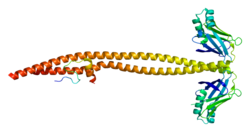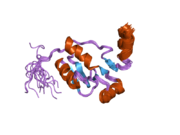LIG4
LIG4디엔에이 리가제4는 인간에게 있어 LIG4 유전자에 의해 암호화된 효소다.[5]
함수
이 유전자에 의해 인코딩된 단백질은 ATP 의존성 DNA 리가아제로서 이중 스트랜드의 비호몰성 엔드 접합 경로 중 이중 스트랜드를 결합하는 것이다.V(D)J 재조합에도 필수적이다.Lig4는 XRCC4로 콤플렉스를 형성하며, 나아가 NHEJ에도 필요한 DNA 의존 단백질 키나아제(DNA-PK)와 XLF/Cernunnos와 상호작용한다.Lig4/XRCC4 단지의 결정구조가 해결되었다.[6]이 유전자의 결함은 LIG4 증후군의 원인이다.Lig4의 효모 호몰로그는 Dnl4이다.
LIG4 증후군
인간에게 있어서 DNA 리가아제 4의 결핍은 LIG4 증후군으로 알려진 임상적 상태를 초래한다.이 증후군은 세포 방사선 감수성, 성장지연, 발달지연, 소두증, 안면이상형, 백혈병에 대한 기질 증가, 면역결핍의 가변 정도, 혈구수 감소 등이 특징이다.[7][8]
조혈모세포 노화
줄기세포 탈진으로 이어지는 DNA 손상의 축적은 노화의 중요한 측면으로 간주된다.[9][10]전지전능 줄기세포에 lig4가 부족하면 비동질적 최종 접합(NHEJ)이 손상되고 DNA 이중 가닥이 파손되고 세포사멸이 강화된다.[8]쥐의 lig4 결핍은 노화 중에 조혈모세포와 골수 세포의 점진적인 손실을 초래한다.[11]lig4 결핍에 대한 조혈모세포의 민감성은 lig4 매개 NHEJ가 시간이 지남에 따라 생리학적 스트레스에 대항하여 스스로를 유지하는 줄기세포의 능력을 결정하는 핵심 결정요인임을 시사한다.[8][11]
상호작용
LIG4는 BRCT 도메인을 통해 XRCC4와 상호작용하는 것으로 나타났다.[12][6]이 상호작용은 세포의 LIG4 단백질을 안정시킨다; XR-1 세포와 같이 XRCC4에 부족한 세포는 LIG4의 수치를 감소시킨다.[13]
메커니즘
LIG4는 ATP에 의존하는 DNA 리가아제다.LIG4는 ATP를 사용하여 아데닐레이트를 만든 다음 AMP 그룹을 하나의 DNA 끝의 5' 인산염으로 전송한다.두 번째 DNA 종단 및 AMP 방출의 3' 히드록실 그룹에 의한 핵포착 공격은 레깅 제품을 산출한다.LIG4의 아데닐화는 XRCC4와 XLF에 의해 자극된다.[14]
참조
- ^ a b c GRCh38: 앙상블 릴리스 89: ENSG00000174405 - 앙상블, 2017년 5월
- ^ a b c GRCm38: 앙상블 릴리스 89: ENSMUSG000049717 - 앙상블, 2017년 5월
- ^ "Human PubMed Reference:". National Center for Biotechnology Information, U.S. National Library of Medicine.
- ^ "Mouse PubMed Reference:". National Center for Biotechnology Information, U.S. National Library of Medicine.
- ^ "Entrez Gene: LIG4 ligase IV, DNA, ATP-dependent".
- ^ a b Sibanda BL, Critchlow SE, Begun J, Pei XY, Jackson SP, Blundell TL, Pellegrini L (December 2001). "Crystal structure of an Xrcc4-DNA ligase IV complex". Nature Structural Biology. 8 (12): 1015–9. doi:10.1038/nsb725. PMID 11702069. S2CID 21218268.
- ^ Rucci F, Notarangelo LD, Fazeli A, Patrizi L, Hickernell T, Paganini T, Coakley KM, Detre C, Keszei M, Walter JE, Feldman L, Cheng HL, Poliani PL, Wang JH, Balter BB, Recher M, Andersson EM, Zha S, Giliani S, Terhorst C, Alt FW, Yan CT (February 2010). "Homozygous DNA ligase IV R278H mutation in mice leads to leaky SCID and represents a model for human LIG4 syndrome". Proceedings of the National Academy of Sciences of the United States of America. 107 (7): 3024–9. doi:10.1073/pnas.0914865107. PMC 2840307. PMID 20133615.
- ^ a b c Tilgner K, Neganova I, Moreno-Gimeno I, Al-Aama JY, Burks D, Yung S, Singhapol C, Saretzki G, Evans J, Gorbunova V, Gennery A, Przyborski S, Stojkovic M, Armstrong L, Jeggo P, Lako M (August 2013). "A human iPSC model of Ligase IV deficiency reveals an important role for NHEJ-mediated-DSB repair in the survival and genomic stability of induced pluripotent stem cells and emerging haematopoietic progenitors". Cell Death and Differentiation. 20 (8): 1089–100. doi:10.1038/cdd.2013.44. PMC 3705601. PMID 23722522.
- ^ Rossi DJ, Bryder D, Seita J, Nussenzweig A, Hoeijmakers J, Weissman IL (June 2007). "Deficiencies in DNA damage repair limit the function of haematopoietic stem cells with age". Nature. 447 (7145): 725–9. doi:10.1038/nature05862. PMID 17554309. S2CID 4416445.
- ^ Bernstein H, Payne CM, Bernstein C, Garewal H, Dvorak K (2008). "Chapter 1: Cancer and aging as consequences of un-repaired DNA damage". In Kimura H, Suzuki A (eds.). New Research on DNA Damages. New York: Nova Science Publishers, Inc. pp. 1–47. ISBN 978-1-60456-581-2.
- ^ a b Nijnik A, Woodbine L, Marchetti C, Dawson S, Lambe T, Liu C, Rodrigues NP, Crockford TL, Cabuy E, Vindigni A, Enver T, Bell JI, Slijepcevic P, Goodnow CC, Jeggo PA, Cornall RJ (June 2007). "DNA repair is limiting for haematopoietic stem cells during ageing". Nature. 447 (7145): 686–90. doi:10.1038/nature05875. PMID 17554302. S2CID 4332976.
- ^ Deshpande RA, Wilson TE (October 2007). "Modes of interaction among yeast Nej1, Lif1 and Dnl4 proteins and comparison to human XLF, XRCC4 and Lig4". DNA Repair. 6 (10): 1507–16. doi:10.1016/j.dnarep.2007.04.014. PMC 2064958. PMID 17567543.
- ^ Bryans M, Valenzano MC, Stamato TD (January 1999). "Absence of DNA ligase IV protein in XR-1 cells: evidence for stabilization by XRCC4". Mutation Research. 433 (1): 53–8. doi:10.1016/s0921-8777(98)00063-9. PMID 10047779.
- ^ Mahaney BL, Hammel M, Meek K, Tainer JA, Lees-Miller SP (February 2013). "XRCC4 and XLF form long helical protein filaments suitable for DNA end protection and alignment to facilitate DNA double strand break repair". Biochemistry and Cell Biology. 91 (1): 31–41. doi:10.1139/bcb-2012-0058. PMC 3725335. PMID 23442139.
추가 읽기
- Wei YF, Robins P, Carter K, Caldecott K, Pappin DJ, Yu GL, Wang RP, Shell BK, Nash RA, Schär P (June 1995). "Molecular cloning and expression of human cDNAs encoding a novel DNA ligase IV and DNA ligase III, an enzyme active in DNA repair and recombination". Molecular and Cellular Biology. 15 (6): 3206–16. doi:10.1128/mcb.15.6.3206. PMC 230553. PMID 7760816.
- Robins P, Lindahl T (September 1996). "DNA ligase IV from HeLa cell nuclei". The Journal of Biological Chemistry. 271 (39): 24257–61. doi:10.1074/jbc.271.39.24257. PMID 8798671.
- Grawunder U, Wilm M, Wu X, Kulesza P, Wilson TE, Mann M, Lieber MR (July 1997). "Activity of DNA ligase IV stimulated by complex formation with XRCC4 protein in mammalian cells". Nature. 388 (6641): 492–5. doi:10.1038/41358. PMID 9242410. S2CID 4349909.
- Critchlow SE, Bowater RP, Jackson SP (August 1997). "Mammalian DNA double-strand break repair protein XRCC4 interacts with DNA ligase IV". Current Biology. 7 (8): 588–98. doi:10.1016/S0960-9822(06)00258-2. PMID 9259561.
- Grawunder U, Zimmer D, Lieber MR (July 1998). "DNA ligase IV binds to XRCC4 via a motif located between rather than within its BRCT domains". Current Biology. 8 (15): 873–6. doi:10.1016/S0960-9822(07)00349-1. PMID 9705934.
- Grawunder U, Zimmer D, Fugmann S, Schwarz K, Lieber MR (October 1998). "DNA ligase IV is essential for V(D)J recombination and DNA double-strand break repair in human precursor lymphocytes". Molecular Cell. 2 (4): 477–84. doi:10.1016/S1097-2765(00)80147-1. PMID 9809069.
- Riballo E, Critchlow SE, Teo SH, Doherty AJ, Priestley A, Broughton B, Kysela B, Beamish H, Plowman N, Arlett CF, Lehmann AR, Jackson SP, Jeggo PA (July 1999). "Identification of a defect in DNA ligase IV in a radiosensitive leukaemia patient". Current Biology. 9 (13): 699–702. doi:10.1016/S0960-9822(99)80311-X. PMID 10395545.
- Kim ST, Lim DS, Canman CE, Kastan MB (December 1999). "Substrate specificities and identification of putative substrates of ATM kinase family members". The Journal of Biological Chemistry. 274 (53): 37538–43. doi:10.1074/jbc.274.53.37538. PMID 10608806.
- Nick McElhinny SA, Snowden CM, McCarville J, Ramsden DA (May 2000). "Ku recruits the XRCC4-ligase IV complex to DNA ends". Molecular and Cellular Biology. 20 (9): 2996–3003. doi:10.1128/MCB.20.9.2996-3003.2000. PMC 85565. PMID 10757784.
- Chen L, Trujillo K, Sung P, Tomkinson AE (August 2000). "Interactions of the DNA ligase IV-XRCC4 complex with DNA ends and the DNA-dependent protein kinase". The Journal of Biological Chemistry. 275 (34): 26196–205. doi:10.1074/jbc.M000491200. PMID 10854421.
- Lee KJ, Huang J, Takeda Y, Dynan WS (November 2000). "DNA ligase IV and XRCC4 form a stable mixed tetramer that functions synergistically with other repair factors in a cell-free end-joining system". The Journal of Biological Chemistry. 275 (44): 34787–96. doi:10.1074/jbc.M004011200. PMID 10945980.
- Riballo E, Doherty AJ, Dai Y, Stiff T, Oettinger MA, Jeggo PA, Kysela B (August 2001). "Cellular and biochemical impact of a mutation in DNA ligase IV conferring clinical radiosensitivity". The Journal of Biological Chemistry. 276 (33): 31124–32. doi:10.1074/jbc.M103866200. PMID 11349135.
- Sibanda BL, Critchlow SE, Begun J, Pei XY, Jackson SP, Blundell TL, Pellegrini L (December 2001). "Crystal structure of an Xrcc4-DNA ligase IV complex". Nature Structural Biology. 8 (12): 1015–9. doi:10.1038/nsb725. PMID 11702069. S2CID 21218268.
- O'Driscoll M, Cerosaletti KM, Girard PM, Dai Y, Stumm M, Kysela B, Hirsch B, Gennery A, Palmer SE, Seidel J, Gatti RA, Varon R, Oettinger MA, Neitzel H, Jeggo PA, Concannon P (December 2001). "DNA ligase IV mutations identified in patients exhibiting developmental delay and immunodeficiency". Molecular Cell. 8 (6): 1175–85. doi:10.1016/S1097-2765(01)00408-7. PMID 11779494.
- Kuschel B, Auranen A, McBride S, Novik KL, Antoniou A, Lipscombe JM, Day NE, Easton DF, Ponder BA, Pharoah PD, Dunning A (June 2002). "Variants in DNA double-strand break repair genes and breast cancer susceptibility". Human Molecular Genetics. 11 (12): 1399–407. doi:10.1093/hmg/11.12.1399. PMID 12023982.
- Mahajan KN, Nick McElhinny SA, Mitchell BS, Ramsden DA (July 2002). "Association of DNA polymerase mu (pol mu) with Ku and ligase IV: role for pol mu in end-joining double-strand break repair". Molecular and Cellular Biology. 22 (14): 5194–202. doi:10.1128/MCB.22.14.5194-5202.2002. PMC 139779. PMID 12077346.
- Roth DB (July 2002). "Amplifying mechanisms of lymphomagenesis". Molecular Cell. 10 (1): 1–2. doi:10.1016/S1097-2765(02)00573-7. PMID 12150897.
- Smogorzewska A, Karlseder J, Holtgreve-Grez H, Jauch A, de Lange T (October 2002). "DNA ligase IV-dependent NHEJ of deprotected mammalian telomeres in G1 and G2" (PDF). Current Biology. 12 (19): 1635–44. doi:10.1016/S0960-9822(02)01179-X. PMID 12361565. S2CID 17749937.
- Roddam PL, Rollinson S, O'Driscoll M, Jeggo PA, Jack A, Morgan GJ (December 2002). "Genetic variants of NHEJ DNA ligase IV can affect the risk of developing multiple myeloma, a tumour characterised by aberrant class switch recombination". Journal of Medical Genetics. 39 (12): 900–5. doi:10.1136/jmg.39.12.900. PMC 1757220. PMID 12471202.










